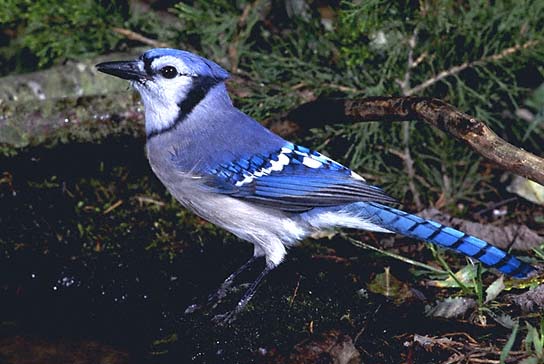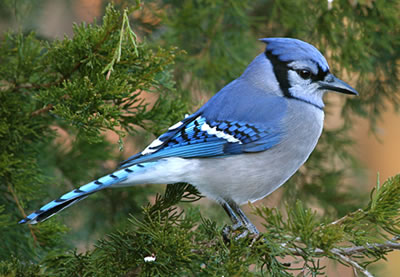
Cyanocitta cristata
SUBFAMILY
Corvinae
TAXONOMY
Cyanocitta cristata Linnaeus, 1758, South Carolina. Four subspecies.
OTHER COMMON NAMES
French: Geai bleu; German: Blauhдher; Spanish: Chara azul.
PHYSICAL CHARACTERISTICS
9.36–11.7 in (24–30 cm); 2.27–3.8 oz (65–109 g). Upperparts
and jaunty crest are purplish blue. Wings and tail are brighter
blue and have prominent black barring; wings also have white
spots. Chin, face, throat and underparts are grayish white.
Long bill, legs, and feet are black.
DISTRIBUTION
Eastern and central North America, with Rocky Mountains
forming broad western limit.
HABITAT
Woodland, parks, and suburbs.
BEHAVIOR
Noisy and bold visitor to many backyards. Generally forages
alone or in pairs.
FEEDING ECOLOGY AND DIET
Highly opportunistic feeder, supplementing a seed and nut diet
with birds, mammals, invertebrates, and human garbage.
REPRODUCTIVE BIOLOGY
Solitary tree nester. Uses mud to hold its twig, root, and
feather nest together. Generally lays four to five eggs late
March through early June. Incubation 16–18 days; fledging
18–21 days. Frequently double brooded.
CONSERVATION STATUS
Not threatened. Very common, with range expanding northwestward.
SIGNIFICANCE TO HUMANS
Iconic status, with the Toronto Blue Jays baseball team, a
record label, and a Beatles song all named after this bird.
Photo Gallery of - Blue jay




 Animalia Life
Animalia Life